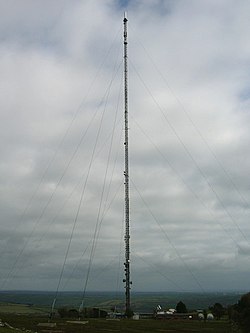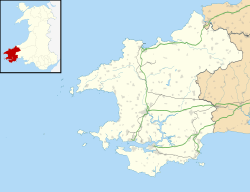 | |
| Mast height | 235.4 metres (772 ft) |
|---|---|
| Coordinates | 51°56′40″N4°39′40″W / 51.944444°N 4.661111°W |
| Grid reference | SN172306 |
| Built | 1962 |
| BBC region | BBC Wales |
| ITV region | ITV Cymru Wales |
The Preseli transmitting station (formerly spelt Presely) is a broadcasting and telecommunications facility on the eastern end of the Preseli Mountains, close to the villages of Crymych and Pentre Galar in Pembrokeshire, Wales (grid reference SN172306 ). It is owned and operated by Arqiva.
Contents
- Transmissions
- Analogue television
- Analogue and digital television
- Digital television
- Analogue radio (FM VHF)
- Digital radio (DAB)
- See also
- References
- External links
It has a 235.4-metre (772 ft) high guyed steel lattice mast. It was constructed in 1962 by the IBA to transmit ITV 405-line television with transmissions commencing on Band III channel 8 from antennas at 559 m (1,835 ft) above sea level. The triangle of antenna arrays aimed beams of signal towards Pembrokeshire, another lobe was directed towards western Carmarthenshire and a northward beam covered south western Cardiganshire. The northward beam from the site also fed the transmitter at Arfon in North Wales.
The Welsh region ITV programming was initially provided by Teledu Cymru which was taken over by TWW in 1964, and eventually HTV Wales who took over from 1968.
In 1971, three protesters from Cymdeithas yr Iaith Gymraeg were jailed for "conspiring to trespass" after gaining access to the site compound and climbing the lower section of the mast. This was part of a series of protests in Wales aiming to get a dedicated Welsh-language TV channel established. The campaign was eventually considered to have been mostly successful with the establishment of S4C (Sianel 4 Cymru) eleven years later.
The site was uprated in 1973 [1] to transmit UHF 625-line PAL analogue television channels, starting with BBC1, BBC2 and HTV Wales, with S4C being added in late 1982. The VHF channel 8 transmissions were discontinued in January 1985 as 405-line TV in the UK was phased out. Channel 5 started analogue TV transmissions in 1997. Six digital TV multiplexes were added in 1998 and the site kept this configuration until 2009, when all analogue television signals were permanently switched off.
The mast also carries Classic FM on 100.5 MHz and Heart South Wales on 105.7 MHz, and transmits national digital radio multiplexes for the BBC and Digital One multiplexes. In 2017, Nation Radio started broadcasting on 107.10 MHz.
The transmitter signals were also received across the Irish sea in many parts of the east and south east coast of the Republic of Ireland, mainly in counties Dublin and Wicklow. From 1962 onward, many households in these counties would point their outdoor aerials towards the Irish sea and could receive transmission from this transmitter. When cable television launched in the early 1970s, the Welsh BBC and ITV stations were provided on the cable platform as these channels were mainly received in the Dublin and Wicklow counties.

